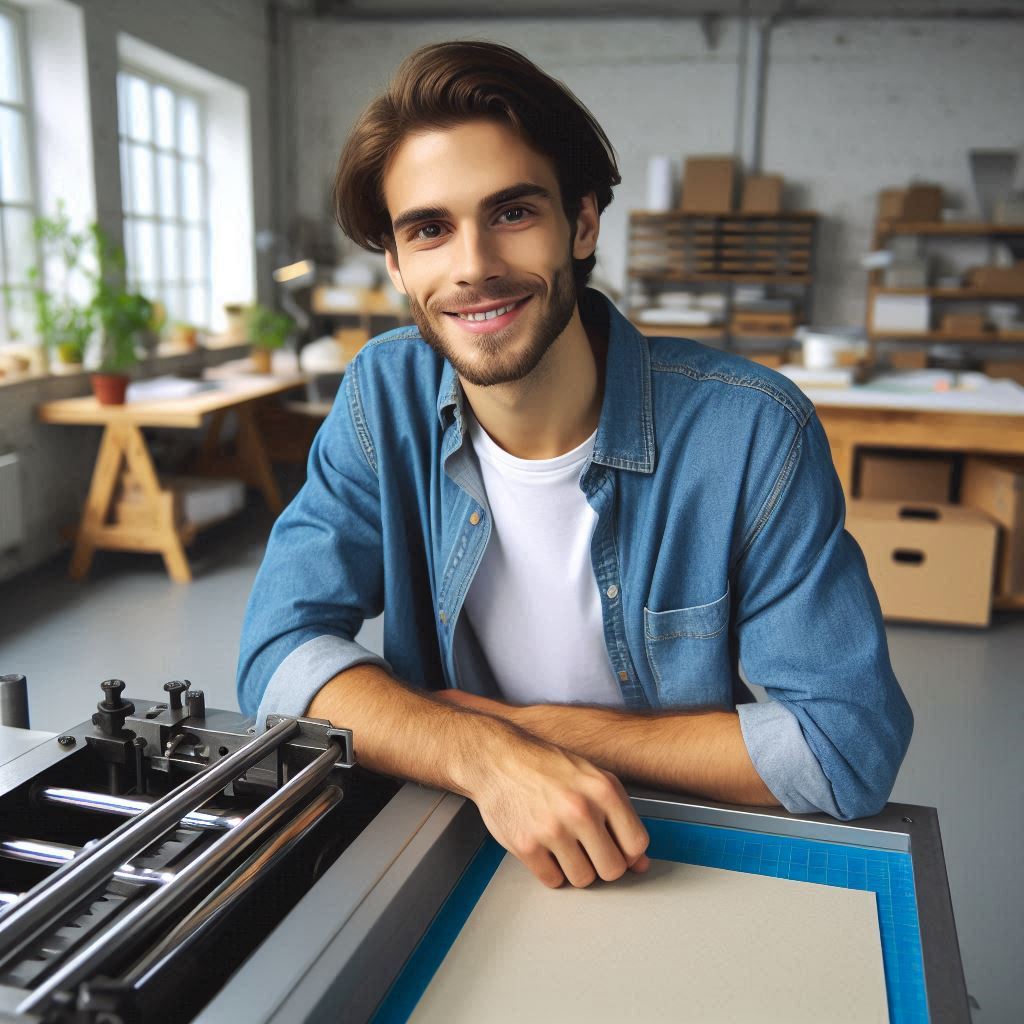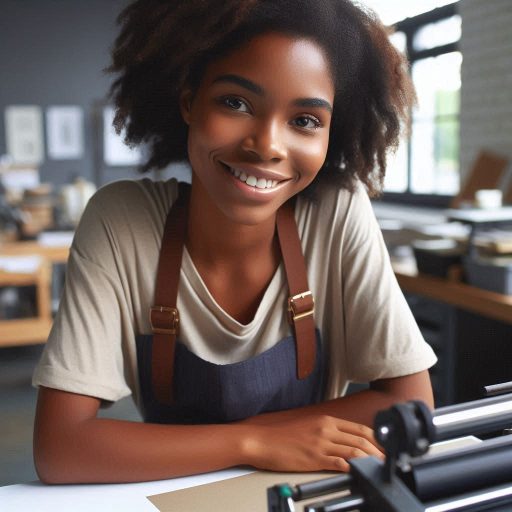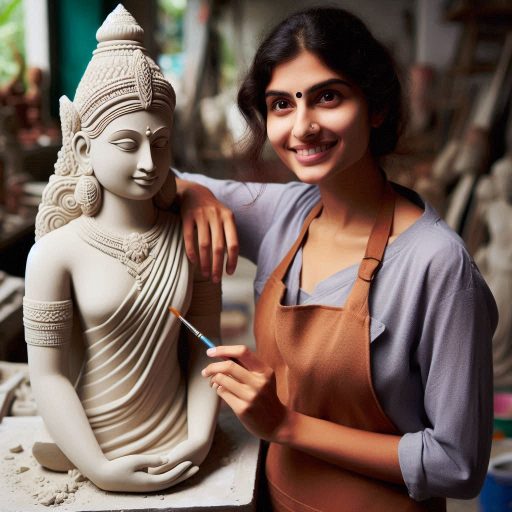Introduction
Printmaking in public art projects brings creativity and engagement into shared spaces.
Artists use printmaking to create large-scale artworks that enhance public environments.
Public art plays a crucial role in fostering community bonds, offering accessible art experiences to everyone.
It encourages interaction and dialogue, helping to unify people from diverse backgrounds.
The significance of public art includes:
- Community engagement: Encourages shared experiences and cultural exchange.
- Accessibility: Brings art into everyday spaces, making it available to all.
- Inspiration: Sparks creativity and fosters pride in local areas.
Printmaking techniques used in public art projects are diverse and adaptable. Artists often employ:
- Screen printing: Ideal for creating large, vibrant designs.
- Woodcut: Allows bold and striking impressions on public surfaces.
- Monoprinting: Offers unique, one-of-a-kind designs tailored to specific spaces.
By integrating printmaking into public art, artists create compelling visuals that enhance the community experience.
These techniques provide a lasting impact on public spaces, making art a meaningful part of everyday life.
History of Printmaking in Public Art
Printmaking has a rich history in public art projects, dating back to ancient civilizations.
One of the earliest forms of printmaking in public art can be traced back to woodblock printing.
Notable artists such as Albrecht D‘rer and Rembrandt van Rijn utilized printmaking in their public art installations.
Printmaking in public art has evolved from traditional techniques to more contemporary and experimental approaches.
Today, printmaking continues to be a popular medium for artists looking to create impactful public art pieces.
Origins of Printmaking in Public Art Projects
The origins of printmaking in public art projects can be traced back to ancient China.
Woodblock printing was one of the earliest forms of printmaking used in public art installations.
During the Renaissance period, artists like Albrecht D‘rer and Rembrandt van Rijn popularized printmaking in public art.
Printmaking in public art projects gained popularity in the 20th century with artists experimenting with new techniques.
Today, printmaking continues to be a versatile medium for artists creating public art installations around the world.
Notable Artists Using Printmaking in Public Art
- Albrecht D‘rer: Known for his intricate woodcuts and engravings used in public art projects.
- Rembrandt van Rijn: Utilized etching techniques in his public art installations during the Renaissance.
- K‘the Kollwitz: German artist known for her powerful and emotive prints used in public art.
- Barbara Kruger: Contemporary artist famous for her bold, text-based prints in public art projects.
- Shepard Fairey: Street artist known for his iconic Obama “Hope” poster created through printmaking.
Evolution of Printmaking in Public Art
Printmaking in public art projects has evolved from traditional techniques to digital and experimental methods.
Advancements in technology have allowed artists to explore new possibilities and push the boundaries of printmaking.
Transform Your Career Today
Unlock a personalized career strategy that drives real results. Get tailored advice and a roadmap designed just for you.
Start NowContemporary artists are incorporating printmaking with other mediums to create dynamic and immersive public art installations.
Printmaking in public art continues to evolve, with artists using it as a tool for social commentary and activism.
As public art becomes more accessible and diverse, printmaking remains a powerful and impactful medium for artists to express their creativity.
In essence, printmaking has a long history in public art projects, with origins dating back to ancient civilizations.
Notable artists like Albrecht D‘rer, Rembrandt van Rijn, and contemporary artists like Shepard Fairey have utilized printmaking in their public art installations.
The evolution of printmaking in public art has seen a shift from traditional techniques to more experimental and contemporary approaches.
As technology advances, artists continue to explore new possibilities and push the boundaries of printmaking in public art, creating impactful and socially relevant installations for communities around the world.
Read: How to Start a Successful Sculpture Business
Types of Printmaking Techniques Used in Public Art
Relief Printing
Relief printing involves carving an image into a surface, applying ink, and transferring it onto another surface.
This technique is commonly used in public art projects because it allows for large-scale production.
Famous examples include woodblock prints seen in Japanese temples and linocuts used in street murals.
Intaglio Printing
Intaglio printing involves incising a design onto a metal plate, applying ink, and transferring it to paper.
The process creates intricate, detailed images and is often used in public art installations.
Notable examples include etchings found in historic buildings and copperplate prints in urban settings.
Lithography
Lithography involves drawing on a flat stone or metal plate with a greasy substance, then printing the image.
This technique is popular in public art projects because it allows for color printing and versatile designs.
Well-known examples include lithographic murals on city walls and posters in public spaces.
Screen Printing
Screen printing involves creating a stencil on a screen and using it to transfer ink onto a surface.
It is a widely used technique in public art due to its ability to produce vibrant, large-scale images.
Famous examples include screen-printed billboards and posters promoting cultural events in cities.
Transform Your Career Today
Unlock a personalized career strategy that drives real results. Get tailored advice and a roadmap designed just for you.
Start NowMonotype Printing
Monotype printing involves creating a unique image on a plate and transferring it to paper.
This technique is favored in public art projects for its expressive and experimental nature.
Notable examples include monotype prints integrated into sculptures and installations in outdoor spaces.
Read: Printmaking: From Concept to Final Piece
Benefits of Using Printmaking in Public Art Projects
Printmaking is a versatile and unique artistic medium that offers a plethora of benefits when utilized in public art installations.
From conveying specific messages to adding a distinctive touch to urban spaces, printmaking plays a significant role in enriching the public art scene.
Adding a Unique Touch to Public Art Installations
Printmaking techniques such as linocut, woodcut, and screen printing bring a one-of-a-kind aesthetic to public art projects.
The textures, patterns, and colors created through printmaking add depth and visual interest to the artwork, making it stand out in the cityscape.
Conveying Specific Messages and Themes
Printmaking allows artists to communicate complex ideas and themes effectively through visual storytelling.
Whether it’s addressing social issues, celebrating cultural heritage, or expressing personal narratives, printmaking provides a platform for artists to convey their messages in a compelling and engaging manner.
Advantages of Using Printmaking Compared to Other Art Forms
- Cost-Effective: Printmaking is a relatively affordable medium, making it accessible to artists of all backgrounds and budgets for public art projects.
- Reproducibility: Printmaking allows artists to create multiple copies of their artwork, enabling them to reach a wider audience and have a broader impact on the community.
- Durability: Prints made through techniques like screen printing and etching are highly durable and can withstand exposure to various weather conditions, making them ideal for outdoor installations in public spaces.
- Collaborative Possibilities: Printmaking encourages collaboration among artists, communities, and organizations, fostering a sense of collective ownership and engagement in public art projects.
- Accessibility: Printmaking is a technique that can be easily learned and practiced by people of all ages and skill levels, promoting inclusivity and diversity in the creation of public art.
In fact, the benefits of using printmaking in public art projects are manifold.
By harnessing the unique qualities of this versatile medium, artists can create engaging, thought-provoking, and visually captivating installations that resonate with the public and enrich urban spaces.
Read: Sculpture Techniques: From Traditional to Modern

Challenges of Incorporating Printmaking in Public Art Projects
Printmaking in public art projects presents unique challenges that artists and designers must consider.
While printmaking can be a versatile and impactful medium for creating art in public spaces, there are several hurdles that need to be addressed to ensure the success and longevity of these projects.
Durability
One of the main challenges of incorporating printmaking in public art projects is the issue of durability.
Prints, especially those made on paper, are susceptible to damage from environmental elements such as rain, wind, and sunlight.
Over time, these prints may fade, tear, or deteriorate if not properly protected.
To overcome the challenge of print durability, artists can consider using more robust materials for their prints, such as canvas or vinyl.
These materials are more resistant to the elements and can withstand outdoor conditions better than traditional paper prints.
Transform Your Career Today
Unlock a personalized career strategy that drives real results. Get tailored advice and a roadmap designed just for you.
Start NowAdditionally, artists can apply UV-resistant coatings or laminates to protect prints from fading due to sunlight exposure.
Maintenance
Maintenance is another significant challenge when incorporating printmaking in public art projects.
Public artworks require regular upkeep to ensure they remain in good condition and continue to be enjoyed by the community.
Prints may need to be cleaned, repaired, or replaced periodically to preserve their aesthetic appeal.
To address maintenance challenges, artists can work closely with local authorities or community organizations to establish a maintenance schedule for public art installations.
Regular inspections and professional cleaning services can help keep prints in top condition and extend their lifespan.
Artists can also involve community members in the maintenance process, fostering a sense of ownership and pride in the artwork.
Environmental factors
Environmental factors also play a crucial role in the success of printmaking in public art projects.
Prints exposed to extreme weather conditions, pollution, or vandalism may be at risk of damage or destruction.
Artists must consider these factors when selecting locations for their prints and take steps to mitigate potential risks.
To address environmental challenges, artists can conduct thorough site assessments before installing prints in public spaces.
They can choose locations that offer protection from harsh weather conditions or reduce exposure to pollutants.
Artists can also collaborate with local authorities to implement security measures to prevent vandalism and ensure the safety of their prints.
In short, while there are challenges associated with incorporating printmaking in public art projects, these hurdles can be overcome with careful planning, thoughtful design, and proactive maintenance strategies.
By addressing issues such as durability, maintenance, and environmental factors, artists can create impactful and enduring artworks that enrich the public spaces they inhabit.
Read: Understanding Printmaking Editions and Proofs
Learn More: Creating Immersive Exhibition Environments
Case Studies of Successful Printmaking Public Art Projects
Examples of successful public art projects that have used printmaking techniques
The High Line in New York City
The High Line is a successful public art project that has incorporated printmaking techniques.
It features murals and installations by artists using various printmaking methods such as silk screening and block printing.
This project has transformed an abandoned railway into a vibrant public space, attracting locals and tourists alike.
Transform Your Career Today
Unlock a personalized career strategy that drives real results. Get tailored advice and a roadmap designed just for you.
Start NowThe Wabash Arts Corridor in Chicago
The Wabash Arts Corridor is another example of a successful printmaking public art project.
Artists have used printmaking techniques to create large-scale murals and street art pieces throughout the corridor.
These installations have revitalized the urban landscape, creating a dynamic outdoor gallery for the community to enjoy.
The Philadelphia Mural Arts Program
The Philadelphia Mural Arts Program is the largest public art program in the United States and has integrated printmaking into many of its projects.
Artists collaborate with local communities to create murals that reflect the city’s diverse cultural heritage.
These printmaking installations have fostered community pride and engagement, transforming neighborhoods into vibrant cultural hubs.
The POW! WOW! Street Art Festival
The POW! WOW! Street Art Festival is a global art movement that brings together artists from around the world to create murals and installations in public spaces.
Many artists participating in the festival use printmaking techniques to translate their designs onto walls and buildings.
These printmaking projects have enlivened urban environments, turning bland walls into colorful works of art that inspire and engage the community.
The Detroit Beautification Project
The Detroit Beautification Project is a grassroots initiative that uses printmaking to transform abandoned buildings and vacant lots into art installations.
Local artists work with community members to create murals and public art pieces that reflect Detroit’s rich artistic heritage.
These printmaking projects have helped revitalize neglected areas, bringing beauty and creativity to the city’s urban landscape.
How these projects have impacted the community and the surrounding environment
These successful printmaking public art projects have had a significant impact on the communities and environments in which they are located.
By utilizing printmaking techniques, artists have been able to create visually stunning and emotionally impactful installations that engage and inspire viewers.
These projects have not only beautified public spaces but have also fostered community pride, cultural appreciation, and social cohesion.
The creativity and innovation displayed in these printmaking installations serve as an inspiration for future public art projects, demonstrating the power of art to transform and enrich our shared spaces.
Community Engagement in Printmaking Public Art Projects
Role of community involvement in printmaking public art projects
Community involvement plays a vital role in printmaking public art projects.
It fosters a sense of ownership and pride in the artwork.
When community members contribute, the project becomes more personal and relevant to them.
Artists often see their work take on new significance when shaped by community input.
Transform Your Career Today
Unlock a personalized career strategy that drives real results. Get tailored advice and a roadmap designed just for you.
Start NowHow artists collaborate with community members to create meaningful and relevant artwork
Artists collaborate with community members to ensure the art reflects local culture and identity.
This collaboration can include workshops, open discussions, and feedback sessions.
These interactions allow artists to create meaningful pieces that resonate with the people who live in the area.
Strategies for engaging the community in the design and execution of public art projects
To effectively engage the community, artists use various strategies.
Hosting workshops where residents learn printmaking techniques is a common approach.
This hands-on experience allows them to participate in the design and execution of the project.
Open forums are another useful tool.
Artists can gather ideas and insights, ensuring that the final work reflects the community‘s shared vision.
Additionally, artists might organize public exhibitions of early designs or concepts.
This provides an opportunity for community members to offer feedback and suggestions.
The artist then refines the work to incorporate these ideas, fostering a deeper connection between the artwork and the people it represents.
In a nutshell, community engagement in printmaking public art projects enhances the relevance and impact of the artwork.
By involving residents in both the design and execution, artists can create pieces that truly reflect the spirit of the community.
Engaging the public through workshops, discussions, and exhibitions ensures that the final project is meaningful to everyone involved.
Conclusion
Printmaking plays a crucial role in public art projects.
It offers a unique and versatile approach that can add depth and meaning to any community space.
Printmakers have the ability to convey powerful messages through their artwork, making it accessible and engaging for a wide audience.
The process of printmaking allows for experimentation and creativity, producing visually stimulating pieces that can transform public spaces into vibrant cultural hubs.
By incorporating printmaking into public art projects, communities can foster a sense of connection, pride, and identity.
It serves as a catalyst for dialogue, sparking conversations and inspiring change.
Transform Your Career Today
Unlock a personalized career strategy that drives real results. Get tailored advice and a roadmap designed just for you.
Start NowAs we continue to explore the intersection of printmaking and public art, we encourage readers to appreciate the beauty and impact of this art form.
Let us embrace printmaking as a tool for social change and cultural expression, and let us support artists who use this medium to enrich our public spaces.
Printmaking in public art projects is not just about creating aesthetic pieces, but about fostering community engagement and creating a lasting legacy for future generations to enjoy.
We invite you to explore and celebrate printmaking in the context of public art installations, as it has the power to transform our surroundings and unite us through shared experiences.




